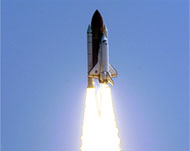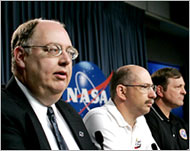Discovery docks at space station
Discovery has docked at the international space station after performing an unprecedented back flip to allow those on board the outpost to photograph the shuttle’s belly for signs of damage.

The digital camera images will be analysed by Nasa to spot any signs of trouble.
Discovery was just 180m beneath the station when Commander Eileen Collins manually steered the shuttle’s nose up and slowly flipped the spacecraft over.
Collins then repositioned the shuttle and locked onto the station.
About two hours later, following leak and pressure checks, Discovery’s astronauts entered the orbital lab, where they were greeted with hugs and bread and salt – a Russian tradition thought to bring good luck when visiting another’s home.
The station’s crew then took Discovery’s astronauts on a tour.
“We’re looking forward to seeing you guys,” Collins told station Commander Sergei Krikalev when the shuttle was a little more than 1520m from the station. “Your space station looks absolutely beautiful from the outside.”
It was the first time a shuttle docked at the station in almost three years. A crew last visited the outpost in November 2002.
Future flights grounded
The docking came after a huge setback on Wednesday, when Nasa decided to ground future shuttle flights because a chunk of insulating foam flew off Discovery’s fuel tank during lift-off – as it did in Columbia‘s doomed mission.
This time, the foam apparently missed the spacecraft.
 |
|
Nasa says it has grounded all |
Discovery was the first shuttle to return to orbit in the two and a half years since Columbia broke apart over Texas as it returned to Earth on 1 February 2003, killing all seven astronauts on board.
The space agency believed it had solved problems associated with the foam on the external fuel tank, but learned otherwise on Wednesday.
The foam prevents the formation of ice on the fuel tank.
“We have got to go take a look at this, and we have got to go find a solution to this problem. And we will,” shuttle programme manager Bill Parsons said.
Supplies
Discovery comes loaded with 15 tonnes of much-needed supplies, including a replacement gyroscope for one that failed in March.
Gyroscopes help steer the station. The shuttle crew planned to leave with 13 tonnes of trash stowed at the station since shuttles were grounded.
Krikalev, a Russian cosmonaut, and astronaut US John Phillips used two digital cameras to snap 100 seconds worth of photos of the shuttle as it flipped backward, exposing its thermal tile belly.
|
“We have got to go take a look at this, and we have got to go find a solution to this problem. And we will” Bill Parsons, |
The photographs were expected to provide resolution similar to a person standing within a few inches of the shuttle’s tiles.
The digital photos, downloaded after docking, are what Nasa officials said they are most interested in.
A team of special analysts at Nasa’s Johnson Space Centre in Houston plan to examine them for any indications of damage.
In addition to the chunk of foam that broke from Discovery’s external fuel tank during launch, several smaller pieces broke away as well.
Thermal tile damage
A thermal tile on Discovery’s belly was also damaged soon after lift-off.
One tile near the doors of Discovery’s landing gear – a particularly vulnerable spot – lost a 4-cm piece that was repaired before the flight.
Deputy shuttle programme manager Wayne Hale said none of the tile damage looked serious and likely would not require the use of untested repair techniques in orbit designed after Columbia.
“We don’t really have a mechanism for knowing why a part of that tile came off,” Hale said.
 |
|
Deputy manager Wayne Hale (L) |
A planned inspection of Discovery’s wings and nose using a new 15-m, laser-tipped extension to the shuttle’s robotic arm turned up nothing alarming, he said.
However, analysis will continue for the next four to five days.
Hale and Parsons said despite attention to the agency’s decision to ground future missions, Nasa’s focus remains on Discovery’s mission and bringing its crew home at the end of its 12-day mission.
“We have had some extremely great successes within this mission,” Parsons said.